Register South African design online
Applicants (both foreign and South African) can now file South African design applications online. The GlobalIPCo online filing system provides for:
- priority claims for convention design applications;
- selection of Aesthetic type designs or Functional type designs;
- disclaimer of portions of the design shown in broken lines;
- addition of an Explanatory Statement;
- payment by credit card; and
- monitoring and management of prosecution of your design to grant via an online dashboard.
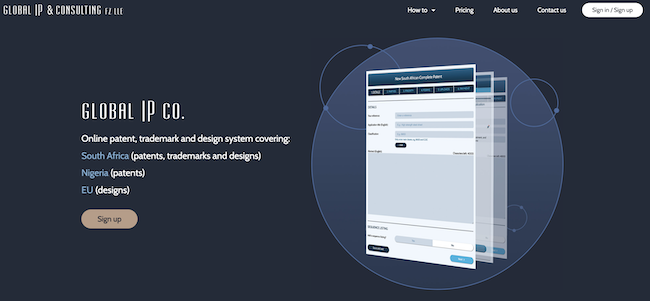
Since the GlobalIPCo system electronically files design registrations directly with the South African Designs Office (CIPC), the cost to file a South African design is now only US$299.
How to file a South African design application online
STEP 1: Login to the GlobalIPCo South African design filing system
Visit the GlobalIPCo design filing website and click “Sign in / Sign up:
Either register a new account, or login using your username and password:
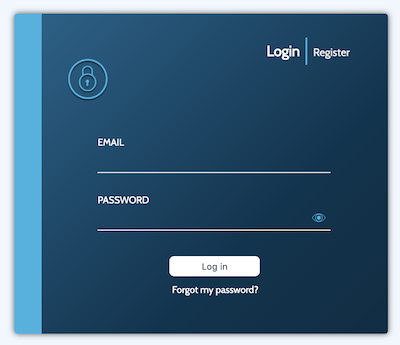
Then, select: New Cases; South Africa; Design.
STEP 2: Article
The Title / Article is a high-level description of the product that is the subject of the design application. We suggest that you refer to the Article in broad terms. For example, use: “shoes” instead of “running shoes”; “bottle” instead of “milk bottle”, and “lamp” instead of “LED lamp”.
Add your reference (optional) – this will be associated with all related correspondence and invoices.
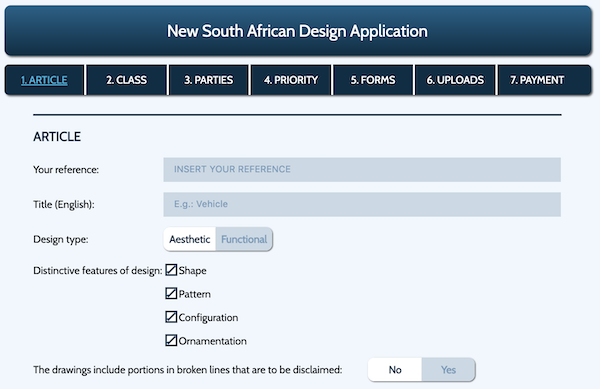
STEP 3: Design type
South African design law provides for registration of “Aesthetic” and “Functional” designs. This does not mean that all functional products should be filed as functional designs. Rather, should you wish to protect the features of shape of a product, where the features of shape have been:
- selected because of their aesthetic value, an Aesthetic design should be filed; or
- dictated by the function to be performed, a Functional design should be filed.
For example, the general shape of a chair would typically be filed as an Aesthetic design, whereas the shape / configuration of strengthening ribs and connectors would typically be filed as Functional designs.
Note: Functional designs may not be filed for “spare parts” (i.e. parts that are expected to be replaced during the life of the parent part).
Generally, applicants file both Aesthetic and Functional designs, as most articles include features that are covered by both Aesthetic and Functional designs.
STEP 4: Shape / Pattern / Configuration / Ornamentation
Aesthetic designs may select all the categories: shape, pattern, configuration and ornamentation; whereas Functional designs may not select ornamentation.
If in doubt, select all available categories, as they are linked with “and/or”.
STEP 5: Disclaimer using broken lines (optional)
Portions of an article that are made separately may be “disclaimed” by drawing them in broken lines. This means that, should a competitor change the shape of the disclaimed portion, such changes will not be relevant to infringement of your design. Example:
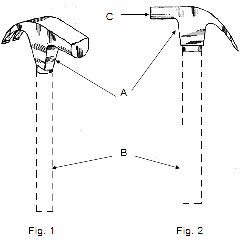
Most South African designs do not include disclaimed portions.
STEP 6: Explanatory Statement (optional)
A short Explanatory Statement may be added to explain the design. The statement may include reference numerals that are associated with parts identified in the drawings. Most South African designs do not include Explanatory Statements. However, Explanatory Statements are mandatory for “mask works” (i.e. functional designs that cover the layout of a circuit board).
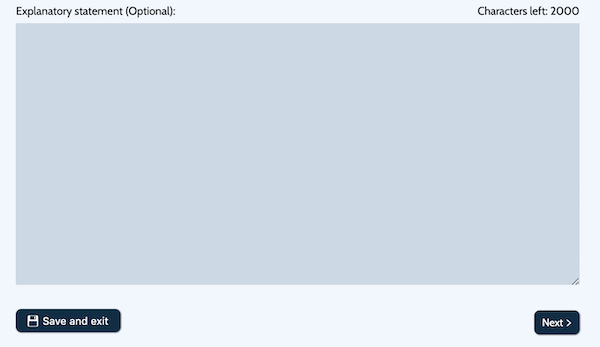
STEP 7: Classification
Only the main Locarno class should be cited (e.g. Class 9 for containers). South Africa does not require designs to be classified in a sub-class. It is important to ensure that the design is correctly classified, as the design is only enforceable against other products within the same class. If a design straddles two classes, we suggest that you file the design in both classes.
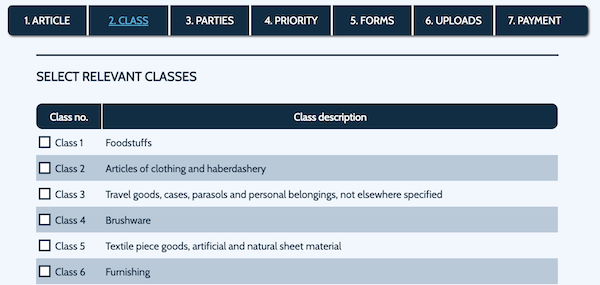
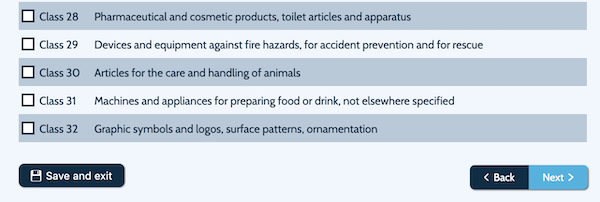
STEP 8: Applicant
The applicant may be a natural person, a juristic person (e.g. a company) or a trust. Co-applicants are also permitted.
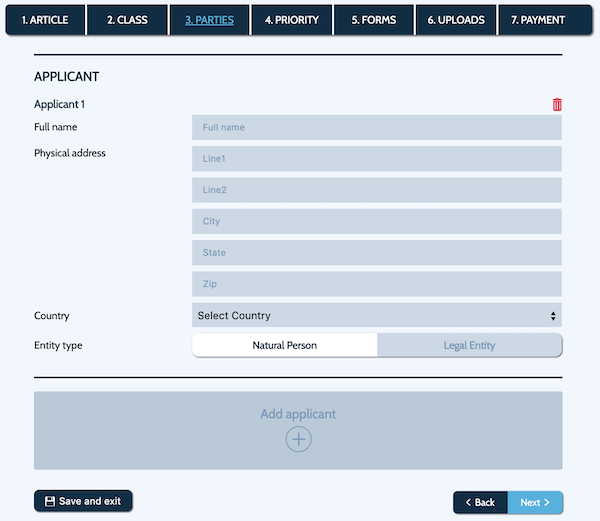
STEP 9: Priority claim (optional)
Where the South African design application is filed within 6 months of filing the first foreign design application, the South African design application may claim priority from the foreign design application. An electronic copy of the priority document (i.e. foreign design application) must be uploaded. And, where the foreign design is not in English, a certified English translation of the foreign priority document must be filed.
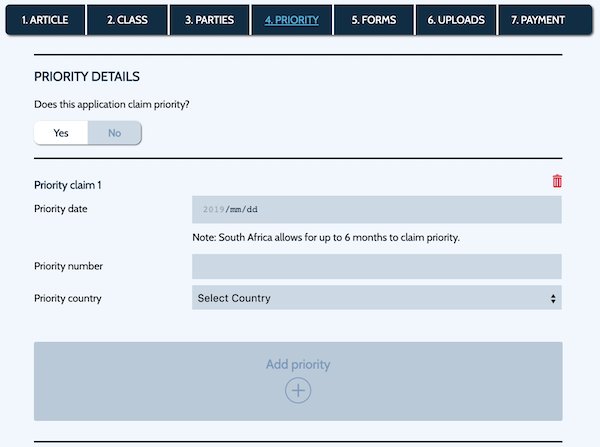
STEP 10: Release date (optional)
South Africa permits public disclosure of a design 6 months prior to the filing date. However, the date of first public release must then be claimed as a “release date”.
Where priority is claimed, no release date should be added.

STEP 11: Design application forms
After completing the above inputs and clicking “Save”, a copy of the South African design application forms that require signature can be sent to you by email. The Declaration Form D3 and the Power of Attorney must be signed by the applicant and, where the applicant is not the designer, each designer should sign the Confirmatory Deed of Assignment. The Power of Attorney empowers us (Sibanda & Zantwijk Attorneys) to file the design application in the applicant’s name.

Note: a confidentiality undertaking may also be downloaded, confirming that your design will be maintained secret.
STEP 12: Drawings / photos
Prepare a set of drawings or photos. We suggest preparing a set of black and white photos showing the front, back, left, right, top, bottom and perspective views. Exploded views are permitted. However, each design application may show only one embodiment of the article.
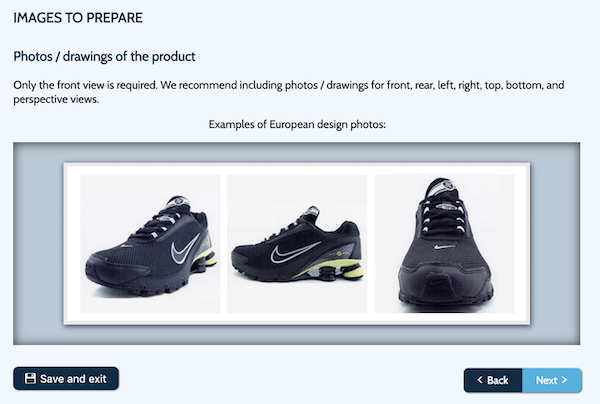
STEP 13: Upload forms and photos / drawings
The Form D3, and Power of Attorney must be signed by the applicant and uploaded. Alternatively, the applicant may use the e-signing feature available on the webpage – South African designs may now be filed even if you have no access to a printer or scanner.
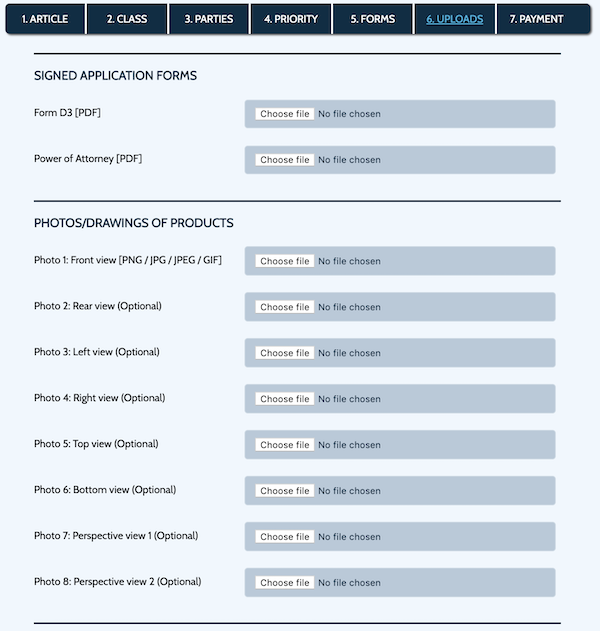

Note: no legalisation or notarisation of the signed forms is required, and we do not require the original signed forms to be couriered to us.
STEP 14: Accept T&Cs and Pay
Finally, accept the T&Cs and make payment of $299 by credit card.
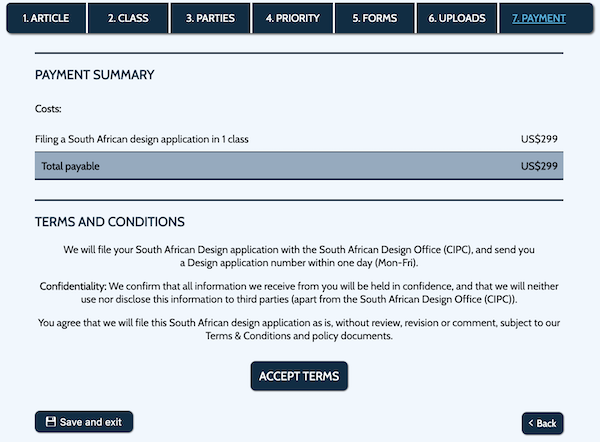
Your South African design application will immediately be filed with the South African Designs Office (CIPC) and the GlobalIPCo system will send you a design application number (together with a copy of the filing receipt) within a business day of filing.
Prosecution of your design to grant is easily managed and instructed via the online dashboard, which also details estimated dates for upcoming events. South Africa does not conduct substantive examination of design applications. So, your design application should be accepted within 9 months of filing. Within 3 months of acceptance, your design should be advertised in the Designs Journal and granted ($70). Within 14 months of filing, we should receive a certified copy of your South African registered design, which will be scanned and emailed to you. The original design registration certificate can also be couriered to you ($110). Should you require additional assistance during prosecution, we (as the exclusive GlobalIPCo agents in South Africa) will be glad to assist.
